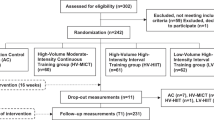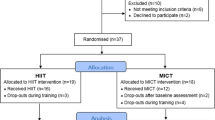Abstract
Purpose
The effectiveness of exercise to lower blood pressure may depend on the type and intensity of exercise. We study the short-term (i.e., 14-h) effects of a bout of high-intensity aerobic interval training (HIIT) on blood pressure in metabolic syndrome (MetS) patients.
Methods
Nineteen MetS patients (55.2 ± 7.3 years, 6 women) entered the study. Eight of them were normotensive and eleven hypertensive according to MetS threshold (≥130 mmHg for SBP and/or ≥85 mmHg for DBP). In the morning of 3 separated days, they underwent a cycling exercise bout of HIIT (>90% of maximal heart rate, ~85% VO2max), or a bout of isocaloric moderate-intensity continuous training (MICT; ~70% of maximal heart rate, ~60% VO2max), or a control no-exercise trial (REST). After exercise, ambulatory blood pressure (ABP; 14 h) was monitored, while subjects continued their habitual daily activities wearing a wrist-band activity monitor.
Results
No ABP differences were found for normotensive subjects. In hypertensive subjects, systolic ABP was reduced by 6.1 ± 2.2 mmHg after HIIT compared to MICT and REST (130.8 ± 3.9 vs. 137.4 ± 5.1 and 136.4 ± 3.8 mmHg, respectively; p < 0.05). However, diastolic ABP was similar in all three trials (77.2 ± 2.6 vs. 78.0 ± 2.6 and 78.9 ± 2.8 mmHg, respectively). Motion analysis revealed no differences among trials during the 14-h.
Conclusion
This study suggests that the blood pressure reducing effect of a bout of exercise is influence by the intensity of exercise. A HIIT exercise bout is superior to an equivalent bout of continuous exercise when used as a non-pharmacological aid in the treatment of hypertension in MetS.




Similar content being viewed by others
Abbreviations
- ABP:
-
Ambulatory blood pressure (systolic and diastolic)
- BMI:
-
Body mass index
- DBP:
-
Diastolic blood pressure
- GXT:
-
Graded exercise testing
- HIIT:
-
High-intensity interval training
- HSD:
-
Honest significant difference
- MICT:
-
Moderate-intensity continuous training
- MetS:
-
Metabolic syndrome
- PEH:
-
Post-exercise hypotension
- SBP:
-
Systolic blood pressure
- VO2max :
-
Maximal oxygen consumption
References
Alberti KG, Eckel RH, Grundy SM, Zimmet PZ, Cleeman JI, Donato KA, Fruchart JC, James WP, Loria CM, Smith SC Jr, International Diabetes Federation Task Force on Epedemiology and Prevention; National Heart, Lung, and Blood Institute; American Heart Association; World Heart Foundation; International Atherosclerosis Society; International Association for the Study of Obesity (2009) Harmonizing the metabolic syndrome: a joint interim statement of the International Diabetes Federation Task Force on Epidemiology and Prevention; National Heart, Lung, and Blood Institute; American Heart Association; World Heart Federation; International Atherosclerosis Society; and International Association for the Study of Obesity. Circulation 120(16):1640–1645. doi:10.1161/CIRCULATIONAHA.109.192644
Angadi SS, Bhammar DM, Gaesser GA (2015) Postexercise hypotension after continuous, aerobic interval, and sprint interval exercise. J Strength Cond Res 29(10):2888–2893. doi:10.1519/JSC.0000000000000939
Angeli F, Reboldi G, Verdecchia P (2014) Hypertension, inflammation and atrial fibrillation. J Hypertens 32(3):480–483. doi:10.1097/HJH.0000000000000112
Clement DL, De Buyzere ML, De Bacquer DA, de Leeuw PW, Duprez DA, Fagard RH, Gheeraert PJ, Missault LH, Braun JJ, Six RO, Van Der Niepen P, O’Brien E, Office versus Ambulatory Pressure Study Investigators (2003) Prognostic value of ambulatory blood-pressure recordings in patients with treated hypertension. N Engl J Med 348(24):2407–2415. doi:10.1056/NEJMoa022273
Coats AJ, Conway J, Isea JE, Pannarale G, Sleight P, Somers VK (1989) Systemic and forearm vascular resistance changes after upright bicycle exercise in man. J Physiol 413:289–298
Cornelissen VA, Fagard RH (2005) Effects of endurance training on blood pressure, blood pressure-regulating mechanisms, and cardiovascular risk factors. Hypertension 46(4):667–675. doi:10.1161/01.HYP.0000184225.05629.51
Cornelissen VA, Arnout J, Holvoet P, Fagard RH (2009) Influence of exercise at lower and higher intensity on blood pressure and cardiovascular risk factors at older age. J Hypertens 27(4):753–762. doi:10.1097/HJH.0b013e328322cf60
DeVallance E, Fournier SB, Donley DA, Bonner DE, Lee K, Frisbee JC, Chantler PD (2015) Is obesity predictive of cardiovascular dysfunction independent of cardiovascular risk factors? Int J Obes (Lond) 39(2):244–253. doi:10.1038/ijo.2014.111
Dimeo F, Pagonas N, Seibert F, Arndt R, Zidek W, Westhoff TH (2012) Aerobic exercise reduces blood pressure in resistant hypertension. Hypertension 60(3):653–658. doi:10.1161/HYPERTENSIONAHA.112.197780
Donley DA, Fournier SB, Reger BL, DeVallance E, Bonner DE, Olfert IM, Frisbee JC, Chantler PD (2014) Aerobic exercise training reduces arterial stiffness in metabolic syndrome. J Appl Physiol 116(11):1396–1404. doi:10.1152/japplphysiol.00151.2014
Eicher JD, Maresh CM, Tsongalis GJ, Thompson PD, Pescatello LS (2010) The additive blood pressure lowering effects of exercise intensity on post-exercise hypotension. Am Heart J 160(3):513–520. doi:10.1016/j.ahj.2010.06.005
Giles TD (2006) Circadian rhythm of blood pressure and the relation to cardiovascular events. J Hypertens Suppl 24(2):S11–S16. doi:10.1097/01.hjh.0000220098.12154.88
Goodwin J, Bilous M, Winship S, Finn P, Jones SC (2007) Validation of the Oscar 2 oscillometric 24-h ambulatory blood pressure monitor according to the British Hypertension Society protocol. Blood Press Monit 12(2):113–117. doi:10.1097/MBP.0b013e3280acab1b
Halliwill JR, Buck TM, Lacewell AN, Romero SA (2013) Postexercise hypotension and sustained postexercise vasodilatation: what happens after we exercise? Exp Physiol 98(1):7–18. doi:10.1113/expphysiol.2011.058065
Hermida RC, Ayala DE, Mojon A, Fernandez JR (2011) Decreasing sleep-time blood pressure determined by ambulatory monitoring reduces cardiovascular risk. J Am Coll Cardiol 58(11):1165–1173. doi:10.1016/j.jacc.2011.04.043
Jones H, Pritchard C, George K, Edwards B, Atkinson G (2008) The acute post-exercise response of blood pressure varies with time of day. Eur J Appl Physiol 104(3):481–489. doi:10.1007/s00421-008-0797-4
Keese F, Farinatti P, Pescatello L, Cunha FA, Monteiro WD (2012) Aerobic exercise intensity influences hypotension following concurrent exercise sessions. Int J Sports Med 33(2):148–153. doi:10.1055/s-0031-1291321
Kriemler S, Hebestreit H, Mikami S, Bar-Or T, Ayub BV, Bar-Or O (1999) Impact of a single exercise bout on energy expenditure and spontaneous physical activity of obese boys. Pediatr Res 46(1):40–44
Lynn BM, Minson CT, Halliwill JR (2009) Fluid replacement and heat stress during exercise alter post-exercise cardiac haemodynamics in endurance exercise-trained men. J Physiol 587(Pt 14):3605–3617. doi:10.1113/jphysiol.2009.171199
MacDonald JR (2002) Potential causes, mechanisms, and implications of post exercise hypotension. J Hum Hypertens 16(4):225–236. doi:10.1038/sj.jhh.1001377
MacDonald J, MacDougall J, Hogben C (1999) The effects of exercise intensity on post exercise hypotension. J Hum Hypertens 13(8):527–531
MacInnis MJ, Gibala MJ (2016) Physiological adaptations to interval training and the role of exercise intensity. J Physiol. doi:10.1113/JP273196
Molmen-Hansen HE, Stolen T, Tjonna AE, Aamot IL, Ekeberg IS, Tyldum GA, Wisloff U, Ingul CB, Stoylen A (2012) Aerobic interval training reduces blood pressure and improves myocardial function in hypertensive patients. Eur J Prev Cardiol 19(2):151–160. doi:10.1177/1741826711400512
Morales-Palomo F, Ramirez-Jimenez M, Ortega JF, Pallares JG, Mora-Rodriguez R (2016) Cardiovascular drift during training for fitness in metabolic syndrome patients. Med Sci Sports Exerc. doi:10.1249/MSS.0000000000001139
Morales-Palomo F, Ramirez-Jimenez M, Ortega JF, Pallarés JG, Mora-Rodriguez R (2017) Acute hypotension after high-intensity interval exercise in metabolic syndrome patients. Int J Sports Med. doi:10.1055/s-0043-101911
Mora-Rodriguez R, Ortega JF, Hamouti N, Fernandez-Elias VE, Canete Garcia-Prieto J, Guadalupe-Grau A, Saborido A, Martin-Garcia M, Guio de Prada V, Ara I, Martinez-Vizcaino V (2014) Time-course effects of aerobic interval training and detraining in patients with metabolic syndrome. Nutr Metab Cardiovasc Dis 24(7):792–798. doi:10.1016/j.numecd.2014.01.011
Padilla J, Wallace JP, Park S (2005) Accumulation of physical activity reduces blood pressure in pre- and hypertension. Med Sci Sports Exerc 37(8):1264–1275
Pescatello LS, Fargo AE, Leach CN Jr, Scherzer HH (1991) Short-term effect of dynamic exercise on arterial blood pressure. Circulation 83(5):1557–1561
Pescatello LS, Franklin BA, Fagard R, Farquhar WB, Kelley GA, Ray CA, American College of Sports Medicine (2004a) American College of Sports Medicine position stand. Exercise and hypertension. Med Sci Sports Exerc 36(3):533–553
Pescatello LS, Guidry MA, Blanchard BE, Kerr A, Taylor AL, Johnson AN, Maresh CM, Rodriguez N, Thompson PD (2004b) Exercise intensity alters postexercise hypotension. J Hypertens 22(10):1881–1888
Pescatello LS, Blanchard BE, Van Heest JL, Maresh CM, Gordish-Dressman H, Thompson PD (2008) The metabolic syndrome and the immediate antihypertensive effects of aerobic exercise: a randomized control design. BMC Cardiovasc Disord 8:12. doi:10.1186/1471-2261-8-12
Piepoli M, Isea JE, Pannarale G, Adamopoulos S, Sleight P, Coats AJ (1994) Load dependence of changes in forearm and peripheral vascular resistance after acute leg exercise in man. J Physiol 478(Pt 2):357–362
Ramos JS, Dalleck LC, Tjonna AE, Beetham KS, Coombes JS (2015) The impact of high-intensity interval training versus moderate-intensity continuous training on vascular function: a systematic review and meta-analysis. Sports Med 45(5):679–692. doi:10.1007/s40279-015-0321-z
Sawyer BJ, Tucker WJ, Bhammar DM, Ryder JR, Sweazea KL, Gaesser GA (2016) Effects of high-intensity interval training and moderate-intensity continuous training on endothelial function and cardiometabolic risk markers in obese adults. J Appl Physiol 121(1):279–288. doi:10.1152/japplphysiol.00024.2016
Scuteri A, Laurent S, Cucca F, Cockcroft J, Cunha PG, Manas LR, Mattace Raso FU, Muiesan ML, Ryliskyte L, Rietzschel E, Strait J, Vlachopoulos C, Volzke H, Lakatta EG, Nilsson PM, Metabolic Syndrome and Arteries Research Consortium (2015) Metabolic syndrome across Europe: different clusters of risk factors. Eur J Prev Cardiol 22(4):486–491. doi:10.1177/2047487314525529
Seals DR, Hagberg JM (1984) The effect of exercise training on human hypertension: a review. Med Sci Sports Exerc 16(3):207–215
Shen L, Ma H, Xiang MX, Wang JA (2013) Meta-analysis of cohort studies of baseline prehypertension and risk of coronary heart disease. Am J Cardiol 112(2):266–271. doi:10.1016/j.amjcard.2013.03.023
Stamler R, Stamler J, Riedlinger WF, Algera G, Roberts RH (1978) Weight and blood pressure. Findings in hypertension screening of 1 million Americans. JAMA 240(15):1607–1610
Stensvold D, Tjonna AE, Skaug EA, Aspenes S, Stolen T, Wisloff U, Slordahl SA (2010) Strength training versus aerobic interval training to modify risk factors of metabolic syndrome. J Appl Physiol 108(4):804–810
Tjonna AE, Lee SJ, Rognmo O, Stolen TO, Bye A, Haram PM, Loennechen JP, Al-Share QY, Skogvoll E, Slordahl SA, Kemi OJ, Najjar SM, Wisloff U (2008) Aerobic interval training versus continuous moderate exercise as a treatment for the metabolic syndrome: a pilot study. Circulation 118(4):346–354. doi:10.1161/circulationaha.108.772822
Tjonna AE, Rognmo O, Bye A, Stolen TO, Wisloff U (2011) Time course of endothelial adaptation after acute and chronic exercise in patients with metabolic syndrome. J Strength Cond Res 25(9):2552–2558. doi:10.1519/JSC.0b013e3181fb4809
Weston KS, Wisloff U, Coombes JS (2014) High-intensity interval training in patients with lifestyle-induced cardiometabolic disease: a systematic review and meta-analysis. Br J Sports Med 48(16):1227–1234. doi:10.1136/bjsports-2013-092576
Wilkins BW, Minson CT, Halliwill JR (2004) Regional hemodynamics during postexercise hypotension. II. Cutaneous circulation. J Appl Physiol 97(6):2071–2076. doi:10.1152/japplphysiol.00466.2004
Acknowledgements
This work was partially funded by a Grant from the Spanish Ministry of Economy and Competivity (DEP-2014-52930-R).
Author information
Authors and Affiliations
Corresponding author
Ethics declarations
Conflict of interest
There is no conflict of interest.
Additional information
Communicated by Carsten Lundby.
Rights and permissions
About this article
Cite this article
Ramirez-Jimenez, M., Morales-Palomo, F., Pallares, J.G. et al. Ambulatory blood pressure response to a bout of HIIT in metabolic syndrome patients. Eur J Appl Physiol 117, 1403–1411 (2017). https://doi.org/10.1007/s00421-017-3631-z
Received:
Accepted:
Published:
Issue Date:
DOI: https://doi.org/10.1007/s00421-017-3631-z




